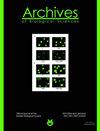One-step purification and freeze stability of papain at acidic pH values
IF 0.8
4区 生物学
Q4 BIOLOGY
引用次数: 2
Abstract
Papain is a proteolytic enzyme of great commercial value. It is a cysteine protease highly expressed in Carica papaya fruit latex, but also present in papaya leaves. Purification procedures mostly deal with the latex and include a combination of precipitation and/or chromatographic techniques. Due to its solubility, structure and activity characteristics, the pH and salt content play significant roles in handling papain extracts. Here we report a simple, rapid and easily scalable procedure for papain purification from papaya leaves, which contain different contaminants as compared to papaya latex. Sodium chloride precipitation of contaminants at pH 5 followed by ammonium sulphate precipitation resulted in the removal of other leaf proteins and protein fragments from papain solution and about a 3-fold purification. The procedure also benefits from the suppression of autoproteolysis and preservation of the native structure, as confirmed by FTIR analysis, and the high recovery of activity of over 80%.木瓜蛋白酶在酸性pH值下的一步纯化和冷冻稳定性
木瓜蛋白酶是一种具有重要商业价值的蛋白水解酶。它是一种半胱氨酸蛋白酶,在番木瓜果实乳胶中高度表达,但也存在于番木瓜叶片中。纯化程序主要处理乳胶,包括沉淀和/或色谱技术的组合。由于其溶解度、结构和活性特性,pH和盐含量对木瓜蛋白酶提取物的处理有重要影响。在这里,我们报告了一种简单,快速和易于扩展的方法,从木瓜叶中纯化木瓜蛋白酶,木瓜叶与木瓜乳胶相比含有不同的污染物。在pH为5的条件下,氯化钠沉淀污染物,然后硫酸铵沉淀,可以去除木瓜蛋白酶溶液中的其他叶片蛋白质和蛋白质片段,纯化约3倍。FTIR分析证实,该过程还受益于抑制自身蛋白水解和保存天然结构,并且活性回收率超过80%。
本文章由计算机程序翻译,如有差异,请以英文原文为准。
求助全文
约1分钟内获得全文
求助全文
来源期刊
CiteScore
1.40
自引率
0.00%
发文量
25
审稿时长
3-8 weeks
期刊介绍:
The Archives of Biological Sciences is a multidisciplinary journal that covers original research in a wide range of subjects in life science, including biology, ecology, human biology and biomedical research.
The Archives of Biological Sciences features articles in genetics, botany and zoology (including higher and lower terrestrial and aquatic plants and animals, prokaryote biology, algology, mycology, entomology, etc.); biological systematics; evolution; biochemistry, molecular and cell biology, including all aspects of normal cell functioning, from embryonic to differentiated tissues and in different pathological states; physiology, including chronobiology, thermal biology, cryobiology; radiobiology; neurobiology; immunology, including human immunology; human biology, including the biological basis of specific human pathologies and disease management.

 求助内容:
求助内容: 应助结果提醒方式:
应助结果提醒方式:


